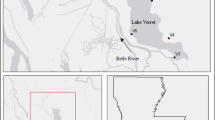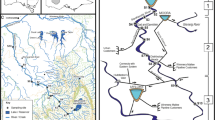Abstract
The present study evaluated the influence of abiotic factors on the periphytic algal community structure under different environmental conditions. Six sampling sites were established along the course of the São Mateus River: two upstream of the city of São Mateus (E1, E2), two along the city (E3, E4), and two downstream of the city (E5, E6). Biotic and abiotic samplings were performed every week, in September and October 2010, totaling four collections. The periphyton was collected from roots of Eichhornia crassipes (Mart.) Solms. removed by scraping with brushes and jets of distilled water, fixed and preserved with formalin 4 % (qualitative analyses) and with acetic lugol 5 % (quantitative analysis). Higher richness of taxa and total density of periphytic algal community were registered in the sampling sites along and downstream of the city of São Mateus, with a greater contribution of Bacillariophyceae (richness) and Cyanophyceae (total density) in all sampling sites. The periphytic algal density was influenced by nutrients (especially nitrogen) and turbidity, as evidenced by the CCA. Thus, it is suggested that the input of allochthonous matter, especially from human activities (intensive fish farming and discharge of domestic and industrial wastewaters) change the water quality (as evidenced by the PCA), as well as communities of periphytic algae present.
Resumo
O presente estudo avaliou a influência dos fatores abióticos sobre a estrutura da comunidade de algas perifíticas submetidas a diferentes condições ambientais. Ao longo do rio São Mateus, seis estações amostrais foram determinadas: duas a montante da cidade de São Mateus (E1, E2), duas ao longo da cidade (E3, E4) e duas a jusante da cidade (E5, E6). As amostragens bióticas e abióticas foram realizadas em intervalos semanais, em setembro e outubro/2010, totalizando quatro coletas. O perifíton foi coletado de raízes de Eichhornia crassipes (Mart.) Solms., removido por raspagem, com pincéis e jatos de água destilada, fixado e preservado com solução de formalina a 4 % (análise qualitativa) e com solução de lugol acético a 5 % (análise quantitativa). Maior riqueza de táxons e densidade total da comunidade de algas perifiticas foi registrada nas estações amostrais ao longo e a jusante da cidade de São Mateus, com maior contribuição das Bacillariophyceae (riqueza) e Cyanophyceae (densidade total) em todas as estações amostrais. A densidade total das algas perifiticas foi influenciada pelos nutrientes (principalmente nitrogênio), assim como pela turbidez, como constatado pela CCA. Assim, podemos sugerir que a entrada de material alóctone, proveniente principalmente das atividades antrópicas (piscicultura intensiva e lançamento de efluentes domésticos e industriais) alteram a qualidade da água (como evidenciado na PCA), assim como as comunidades de algas perifíticas presentes.




Similar content being viewed by others
References
Ács E, Kiss KT (1993) Effects of the water discharge on periphyton abundance and diversity in a large river (River Danube, Hungary). Hydrobiologia 249:125–133
Ács E, Szabó K, Kiss TT, Hindák F (2003) Benthic algal investigations in the Danube River and some of its main tributaries from Germany to Hungary. Biologia (Bratislava) 58:545–554
Agences de L′eau (1993) Étude bibliographique des méthodes biologiques d′évaluation de la qualité des eaux de surface continentales. Synthèse bibliographique. Etude Inter Agences no. 35. I.D.E. Environnement
Alba-tercedor J (1996) Macroinvertebrados Acuaticos y Calidad de las Aguas de los Rios. IV Simposio del Agua en Andalucia. III:203–213
Ayres M, Ayres M Jr, Ayres DL, Santos AS (2007) BioEstat 50, aplicações estatísticas nas áreas das ciências biológicas e médicas. Sociedade Civil de Mamirauá, Belém
ANA—Agência Nacional de Águas (2009) Bacias hidrográficas do Atlântico Sul—trecho leste. http://hidroweb.ana.gov.br/doc/BHASLeste/index.htm. Acesso em 27 Sept 2011
APHA—American Publication Health Association (2005) Standard methods for the examination of water and wastewater. In: Greenberg AE, Clesceri LS, Eaton AD (eds) APHA, Washington, DC
Battin TJ, Kaplan LA, Newbold JD, Hansen CME (2003) Contributions of microbial biofilms to ecosystem processes in stream mesocosms. Nature 426:439–442
Bicudo DC (1990) Considerações sobre metodologias de contagem de algas do perifíton. Acta Limnologica Brasiliensia 3:459–475
Bicudo CEM, Menezes M (2006) Gêneros de algas de águas continentais do Brasil: chave para identificação e descrições. Ed. RiMa, São Carlos
Bojsen BH, Jacobsen D (2003) Effects of deforestation on macroinvertebrate diversity and assemblage structure in Ecuadorian Amazon streams. Arch Hydrobiol 158:317–342
Calisto M, Moretti M, Goulart M (2001) Macroinvertebrados bentônicos como ferramenta para avaliar a saúde de riachos. Revista Brasileira de Recursos Hídricos 6:71–782
Carmouze L (1994) O metabolismo dos ecossistemas aquáticos—Fundamentos teóricos, métodos de estudo e análises químicas. Edgard Blucher, São Paulo
Cascallar L, Mastranduono P, Mosto P, Rheinfeld M, Santiago J, Tsoukalis C, Wallace S (2003) Periphytic algae as bioindicators of nitrogen inputs in lakes. J Phycol 39:7–8
Castro JGD, Forsberg BB, Silva JEC, Santos AC (2008) Fatores controladores da biomassa do ficoperifiton no Rio Jaú—Parque Nacional do Jaú (Amazônia Central). Revista de Biologia e Ciências da Terra 8:93–104
Cetto JM, Leandrini JA, Felisberto SA, Rogrigues L (2004) Comunidade de algas perifíticas no reservatório de Irai, Estado do Paraná, Brasil. Acta Scientiarum Biol Sci Maringá 26:1–7
Esteves FA, Petrucio MM, Figueiredo-barros MP (2011) Sílica nos ecossistemas aquáticos continentais. In: Esteves FA (ed) Fundamentos de Limnologia. Rio de Janeiro, p 293–298
Felisberto SA, Rodrigues L (2005) Comunidade de Algas Perifíticas em reservatórios de diferentes latitudes. In: Rodrigues L, Thomaz SM, Agostinho AA, Gomes LC (eds) Biocenoses em reservatórios: padrões espaciais e temporais. Rima, São Carlos, pp 97–114
Felisberto SA, Rodrigues L (2010) Periphytic algal community in artificial and natural substratum in a tributary of the Rosana reservoir (Corvo Stream, Paraná State, Brazil). Acta Scientiarum. Biol Sci 32:373–385
Felisberto SA, Rodrigues L (2012) Dinâmica sucessional da comunidade de algas perifíticas em um ecossistema lótico subtropical. Rodriguésia (Online) 63:463–473
Fernandes VO, Esteves FA (2011) Comunidade Perifitica. In: Esteves FA (ed) Fundamentos de Limnologia. Ed. Interciências, Rio de Janeiro, pp 447–460
Fonseca IA, Rodrigues L (2007) Periphytic Cyanobacteria in different environments from the upper Paraná River floodplain, Brazil. Acta Limnol Bras 19:53–65
Forsberg RB, Diaz-castro JGD, Cargnin-ferreira E, Rosenqvist A (2001) The structure and function of the Negro River ecosystem: insights from the Jaú Project. In: Conservation and management of ornamental fish resources of the Rio Negro Basin, Amazonia, Brazil—Project Piaba
Giorgi A, Malacalza L (2002) Effect of an industrial discharge on water quality and periphyton structure in a Pampeam stream. Environ Monit Assess 75(2):107–119
Golterman HL, Clymo RS, Ohnstad MAM (1978) Methods for chemical analysis of freshwater, 2nd edn. Blackwell Scientific Publications, Oxford, p 213
Harding JS, Young RG, Hayers JW, Shearer KA, Stark JD (1999) Changes in agricultural intensity and river health along a river continuum. Freshw Biol 42(2):345–357
Hardwick GC, Blinn WD, Usher DH (1992) Epiphytic diatoms on Cladophora glomerata in the Colorado River, Arizona: longitudinal and vertical distribution in a regulated river. Southwest Nat 37(2):148–156
Inove M, Nunokawa M (2005) Spatial variation in density of stream benthic fishes in northern Hokkaido, Japan: does riparian vegetation affect fish density via food availability? Limnology 6:7–14
Irvine RL, Jackson LJ (2006) Spatial variance of nutrient limitation of periphyton in montane, headwater streams (McLeod River, Alberta, Canada). Aquat Ecol 40:337–348
Iwaniec DM, Childers DL, Rondeau D (2006) Effects of hydrologic and water quality drivers on periphyton dynamics in the southern Everglades. Hydrobiologia 569:223–235
Jackson DA (1993) Stopping rules in principal components analysis: a comparison of heuristical and statistical approaches. Ecology 74:2204–2214
Komulaynen S (2004) Ecology of periphyton in small Rivers of easterns Fennoscandia. Karelian Reserarch Center RAN, Petrokzavodsk (In Russian with English summary)
Komulaynen S (2008) The structure and distribution of phytoperiphyton community in the Reno River and its tributaries (Finnish Lapland). Boreal Environ Res 13:517–524
Lamberti GA (1996) The role of periphyton in benthic food webs. In: Stevenson RJ (ed) Algal ecology: freshwater benthic ecosystems, cap. 17. Academic Press, San Diego, pp 533–572
Lampert W, Sommer U (2007) Limnoecology. The ecology of lakes and streams, 2nd edn. Oxford University Press, Oxford
Lévêque C (1996) Ecosystèmes Aquatiques—Les Fondamentaux. HACHETTE Livre, Paris
Lobo E, Leighton G (1986) Estruturas comunitárias de las fitocenosis planctônicas de los sistemas de desembocaduras y esteros de rios de la zona central de Chile. Rev Biol Mar Vina del Mar 22:1–29
Mackereth FJH, Heron J, Talling JF (1978) Water analysis: some revised methods for limnologists. Freshwater Biological Association Scientific Association. Titus Wilson & Son Ltd., Kendall
Margalef R (1983) Limnologia. Omega, Barcelona
Matsumara-Tundisi T, Tundisi JG (1997) Mixing processes affecting primary production of phytoplankton in Barra Bonita reservoir. Verhandlungen Der Internationalen Vereinigung für Theoretische und Angewandtle Limnologie 26:536–541
Mattila J, Räisänen R (1998) Periphyton growth as an indicator of eutrophication; an experimental approach. Hydrobiologia 377:15–23
McCume B, Mefford MJ (2006) PC-ORD: multivariate analysis of ecological data, version 5.14. MJM Software, Gleneden Beach, Oregon
McINTIRE CD (1966) Some effects of current velocity on periphyton communities in laboratory streams. Hydrobiologia 27:559–570
Neves GL (2011) Análise qualitativa preliminar da composição perifítica algal em compartimentos do rio São João, Carambeí—PR. X Congresso de Ecologia do Brasil, São Lourenço
Pereira TA, Felisberto SA, Fernandes VO (2013) (Subject) Caracterização limnológica do rio São Mateus, norte do Espírito Santo (Brasil). Acta Limnologica Brasiliensia
Power ME, Stout RJT, Cushing CE, Harper PP, Hauer FR, Matthews WJ, Moyle PB, Statzner B, Badgen IRW (1988) Biotic and abiotic controls in river and stream communities. J North Am Benthol Soc 7:456–479
Reynolds CS (1984) The ecology of freshwater phytoplankton. Cambridge University Press, Cambridge
Rodrigues L, Bicudo DC (2001) Similarity among periphyton algal communities in a lentic-lotic gradient of the upper Paraná river floodplain, Brazil. Revista Brasileira de Botânica 24:235–248
Sandsten H, Beklioglu M, Özlem O (2005) Effects of waterfowl, large fish and periphyton on the spring growth of Potamogeton pectinatus L. in Lake Mogan, Turkey. Hydrobiologia 537:239–248
Scott TL, Scott RS (2000) Light- and nutrient limited periphyton in low order streams of Oahu, Hawaii. Hydrobiologia 432(1–3):101–111
Silva WJ, Felisberto SA, Fonseca CP, Souza MGM (2010) Serial discontinuity along the Descoberto River Basin, Central Brazil. Acta Limnologica Brasiliensia 22:344–355
Silva FH, Favero S, Sabino J, Garnés SJA (2011) Índices bióticos para avaliação da qualidade ambiental em trechos do rio Correntoso, Pantanal do Negro, Estado de Mato Grosso do Sul, Brasil. Acta Scientiarum. Biological Sciences Maringá 33:289–299
Siva CJ, John J (2002) Urban land use and periphytic diatom communities: a comparative study of three metropolitan streams in Perth, Western Australia. In: Proceedings of the 15th international diatom symposium, Perth, Australia, 28 September–2 October 1998, pp 125–134
Strickland JD, Parsons TR (1960) A manual of sea water analysis. Bull Fish Res Board Can 125:1–185
Uehlinger V (1964) Étude statistique dês méthodes de dénobrement planctonique. Archives des Sciences, Geneve 17:121–123
Utermöhl H (1958) Zur vervollkommung der quantitativen phytoplankton-methodik. Verh. Int. Ver. Theor. Angew. Limnol Stuttgart 9:1–38
Valderrama JC (1981) The simultaneous analysis of total nitrogen and phosphorus in natural waters. Mar Chem 10:1109–1122
Ward JV, Stanford AJ (1983) The serial discontinuity concept of lotic ecosystems. In: Fontaine TD, Bartell SM (eds) Dynamics of lotic ecosystems. Ann Arbor Science Publishers Inc., Ann Arbor, pp 29–42
Ward JV, Stanford JA (1995) The serial discontinuity concept: extending the model to floodplain rivers. Regul Rivers Res Manage 10:159–168
Wetzel RG (1996) Benthic algae and nutrient cycling in lentic freshwater ecosystems. In: Stevenson RJ, Bothwell ML, Lowe RL (eds) Algal ecology: freshwater benthic ecosystems. Academic Press, San Diego, pp 641–667
Acknowledgments
The authors thank to the Fishermen Association of the Juara Lagoon for logistic support and help, to the Laboratory of Taxonomy and Ecology of Freshwater Algae (LATEAC) for laboratory analysis and to the Laboratory of Environmental Sciences (UENF)—Ecology Laboratory, for helping in analyses of nutrients, and to CAPES (Coordination of Improvement of Higher Education Personnel) and to the Graduate Program in Tropical Biodiversity, for the scholarship to the first author.
Author information
Authors and Affiliations
Corresponding author
Rights and permissions
About this article
Cite this article
de Almeida Pereira, T., Felisberto, S.A. & de Oliveira Fernandes, V. Longitudinal variation of periphytic algal community structure in a tropical river. Braz. J. Bot 36, 267–277 (2013). https://doi.org/10.1007/s40415-013-0034-1
Received:
Accepted:
Published:
Issue Date:
DOI: https://doi.org/10.1007/s40415-013-0034-1




